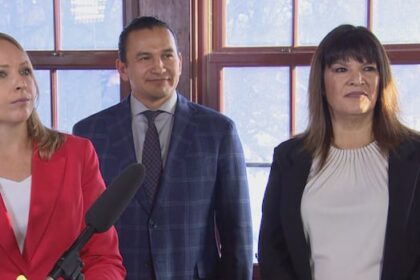NorthJohn Main, chosen on Tuesday to be Nunavut’s next premier, has lots of ideas for things he wants to improve in the next four years. The first step, he says, is coming together with his colleagues to develop a mandate.’We have to make some tough decisions around what we want to prioritize,’ says John MainCBC News · Posted: Nov 19, 2025 2:41 PM EST | Last Updated: November 19Listen to this articleEstimated 7 minutesThe audio version of this article is generated by text-to-speech, a technology based on artificial intelligence.John Main, Nunavut’s next premier, has lots of ideas for things he wants to improve in the next 4 years. The first step, he says, is coming together with other MLAs to develop a mandate. (Anais Elboujdaini/Radio-Canada)Nunavut’s next premier, John Main, says decentralizing government jobs from Iqaluit, increasing Inuit employment, infrastructure and education are all major issues he’s looking to advance. But first, he needs to get sworn in. Main, 45, was elected as the next premier on Tuesday, beating out David Akeeagok in a secret ballot vote at the territory’s leadership forum. Main is a third-term MLA from Arviat who speaks fluent Inuktitut and served as Nunavut’s health minister in the previous assembly. It’s the first time Nunavut will have a non-Inuk leader.Main spoke with the CBC’s Quilliq host Eli Qaqqasiq-Taqtu on Wednesday morning about what comes next.This interview has been edited for length and clarity.This is a new fresh start as a premier. So what are your main priorities for the next four years? The next big step for us is to develop a mandate, that’s the document that will guide us for the next four years, set out our priorities. They say if everything’s a priority, then nothing’s a priority — so we have to make some tough decisions around what we want to prioritize. I would expect to see items around housing, education, health care, support for food security, unemployment. You know, these are kind of the things that really, I think, Nuannvummiut bring to MLA candidates when it’s election time. And it’s our job to get things done and to make improvements. The other big step is getting our new ministers established into their portfolios, and looking at the cabinet that was put in place yesterday. Members of Nunavut’s Legislative Assembly gathered Tuesday to vote in a new premier, Speaker, and cabinet ministers. (Anais Elboujdaini/Radio-Canada)So I’m looking at the MLAs asking the questions to you guys yesterday, what stood out to you?It was a great discussion. And I mean, my colleague, Minister Akeeagok, who also tried for premier, I have the utmost respect for him and worked alongside him for a number of years. And just sitting there, I felt like, ‘gee, it would be nice if we can continue this discussion because I feel like we’re going somewhere towards a solution.’ And that, in some ways, it was a little bit of a teaser for the types of discussions and debates that go into developing the mandate. It’s about bringing together the best ideas and the best solutions for Nunnavummuit. And you know, those aren’t all going to come from one person. They’re not all going to come from one community. They’re going to come from right across the territory and it’s through working together in the Assembly and working together outside of the Assembly that we’re going to do things, good things, for Nunavummuit.You are no stranger to the political sides of devolution. How satisfied are you with the progress that has been made for that second anniversary of the devolution?We’re working towards 2027, which is the date in which the transfer over of many of the functions will happen. And so my understanding is that the work’s on track, it was a major achievement for Premier [P.J.] Akeeagok to sign the final agreement with Prime Minister Trudeau. It takes multiple governments, it took multiple governments working on devolution. So it wasn’t just Premier Akeeagok, it was also Premier [Joe] Savikataaq, Premier [Paul] Quassa before him. It took several successive governments to get the devolution file to the final agreement stage. And our government is going to be the one that brings it to the implementation point and it’s going to be a challenge. But I feel that we’re up for the challenge. It’s an important step forward for Nunavut in terms of taking those responsibilities from the federal government.The government of Nunavut has struggled to meet its Inuit employment goals. What are you going to do to increase the number of Inuit government positions, or in Nunavut in general?This is such an important file. There’s so many different programs that are running through different agencies like the Department of Human Resources, also Nunavut Arctic College, that are focused on getting more Inuit within Nunavut government and then helping those Inuit to advance within the workplace. I’m really excited, in terms of new initiatives that we will be seeing, pre-employment initiatives. That’s with the funding from the new Nunavut implementation contract. It’s really exciting looking at those additional resources, what can we do in terms of training, in terms of education at the community level.I also wanted to mention the need to continue looking at decentralization as a way to increase Inuit employment. We have the ability for employees to work remotely from anywhere in Nunavut. It’s called our Nunavut-wide work policy. I’m really interested to see if that policy can be used to bring the jobs to Inuit as opposed to bringing Inuit to the jobs. Education is vital to ensure people are ready for post-secondary education or the workforce, but Nunavut struggles to hire teachers. So what are you going to do to ensure access to quality education?Education is a cornerstone of the future of Nunavut. There are several concerning areas that we need to address: low attendance rates, the issues around school infrastructure not keeping up with population growth, the issues around recruitment and retention of teachers. There’s no lack of work when it comes to the education file.It needs to be “all hands on deck,” in terms of school food programs, in terms of more infrastructure, more Inuit teachers supporting DEAs [district education authorities]. There’s so many amazing things that are happening in our schools.I think it’s a case of just doing the work and working hard with our partners in terms of maximizing opportunities for children and also making sure that teachers and the staff are supported. They work so hard. Give them the tools they need to do their jobs and good things will come after that.When CBC was interviewing people about their priorities for their next government we heard a lot about aging infrastructure. What are you going to do to ensure the important facilities like health centres and schools are in good condition within the territory?It’s a huge challenge, and it’s impacting Nunnavummuit. One thing we talked about yesterday in the leadership forum is looking at how we build infrastructure, how we build schools, how we build health centres, and taking a real hard look at whether there’s ways we can do it cheaper.If we can build schools cheaper, then we can build more schools. If we can build health centres cheaper, we build more. I hate to say it, but I’m just so greedy for more infrastructure for our territory. We need more schools, power plants, health centres, roads, airports, you know that the list goes on and on and on. And we have limited dollars and it’s a case of making sure that our dollars are going as far as they can in terms of how we build. It’s also about working with partners — the federal government, also Inuit organizations — on shared priorities. I’m really excited to see the recent federal budget has items in it around Arctic infrastructure. It also mentions specifically health infrastructure. My hope is that Nunavummuit will benefit from that interest.Interview by Eli Qaqqasiq-Taqtu
Thursday, 20 Nov 2025
Canada – The Illusion
Search
Have an existing account?
Sign In
© 2022 Foxiz News Network. Ruby Design Company. All Rights Reserved.
You May also Like
- More News:
- history
- Standing Bear Network
- John Gonzalez
- ᐊᔭᐦᑊ ayahp — It happened
- Creation
- Beneath the Water
- Olympic gold medal
- Jim Thorpe
- type O blood
- the bringer of life
- Raven
- Wás’agi
- NoiseCat
- 'Sugarcane'
- The rivers still sing
- ᑲᓂᐸᐏᐟ ᒪᐢᑿ
- ᐅᑳᐤ okâw — We remember
- ᐊᓂᓈᐯᐃᐧᐣ aninâpêwin — Truth
- This is what it means to be human.
- Nokoma












